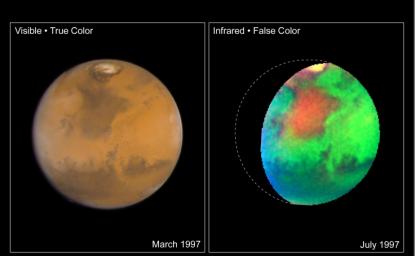
|
Martian Colors Provide Clues About Martian Water
- Click the image above for a larger view
- Full-Res JPEG (3000 x 1850) (230.4 kB)
- Full-Res TIFF (3000 x 1850) (5.1 MB)
Caption:
NASA Hubble Space Telescope images of Mars taken in visible and infrared light detail a rich geologic history and provide further evidence for water-bearing minerals on the planet's surface.
LEFT
This "true-color" image of Mars shows the planet as it would look to human eyes. It is clearly more Earth-toned than usually depicted in other astronomical images, including earlier Hubble pictures. The slightly bluer shade along the edges of the disk is due to atmospheric hazes and wispy water ice clouds (like cirrus clouds) in the early morning and late evening Martian sky. The yellowish-pink color of the northern polar cap indicates the presence of small iron-bearing dust particles. These particles are covering or are suspended in the air above the blue-white water ice and carbon dioxide ice, which make up the polar cap.
Accurate colors are needed to determine the composition and mineralogy of Mars. This can tell how water has influenced the formation of rocks and minerals found on Mars today, as well as the distribution and abundance of ice and subsurface liquid water. Confirmation of the presence of certain oxidized (rusted) minerals (processed by heat or water action) would imply the possibility of different, perhaps much more Earth-like, past Martian climate periods. Because the smallest features visible in this image are only about 14 miles (22 km) across, Hubble can track small-scale variations in the distribution of minerals that do not follow global trends. The image was generated from three separate Wide Field and Planetary Camera 2 images acquired at wavelengths of 410, 502, and 673 nanometers, in March 1997.
RIGHT
A false-color picture taken in infrared light reveals features that cannot be seen in visible light. Hubble's unique infrared view pinpoints variations in the abundance and distribution of unknown water-bearing minerals on the planet. While it has been known for decades that small amounts of water-bearing minerals exist on the planet's surface, the reddish regions in this image indicate areas of enhanced concentrations of these as-yet-unidentified deposits. They are perhaps related to the water-rich history of this part of Mars. In particular, the large reddish region known as Mare Acidalium was the site of massive flooding early in Martian history. (NASA's Pathfinder spacecraft landed at the southern edge of this region in 1997.) This composite image was taken in July 1997 with Hubble's Near Infrared Camera and Multi-Object Spectrometer. Red corresponds to the strength of an absorption band detected near 1450 nanometers; green to the brightness of the surface in the near-infrared; and blue to topographic elevation, determined from Viking Orbiter data.
Cataloging Keywords:
| Name | Value | Additional Values |
|---|---|---|
| Target | Mars | |
| System | ||
| Target Type | Planet | |
| Mission | Hubble Space Telescope (HST) | Viking |
| Instrument Host | Hubble Space Telescope | |
| Host Type | Space Telescope | |
| Instrument | Wide Field/Planetary Camera 2 (WFPC2) | |
| Detector | ||
| Extra Keywords | Atmosphere, Color, Dust, Haze, Infrared, Water | |
| Acquisition Date | ||
| Release Date | 1999-05-21 | |
| Date in Caption | ||
| Image Credit | NASA/JPL/STScI | |
| Source | photojournal.jpl.nasa.gov/catalog/PIA01543 | |
| Identifier | PIA01543 | |
